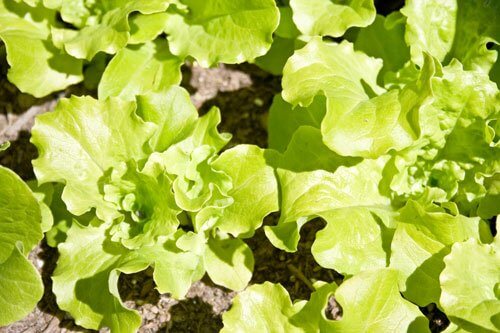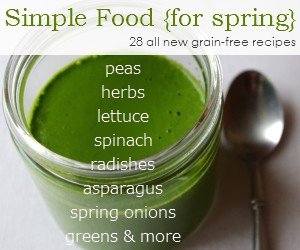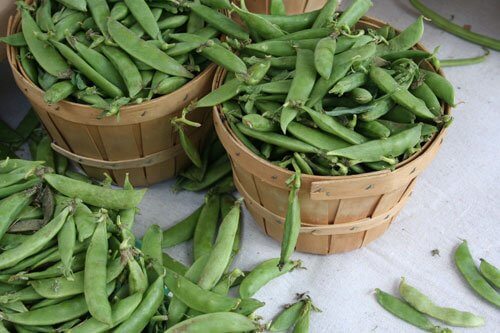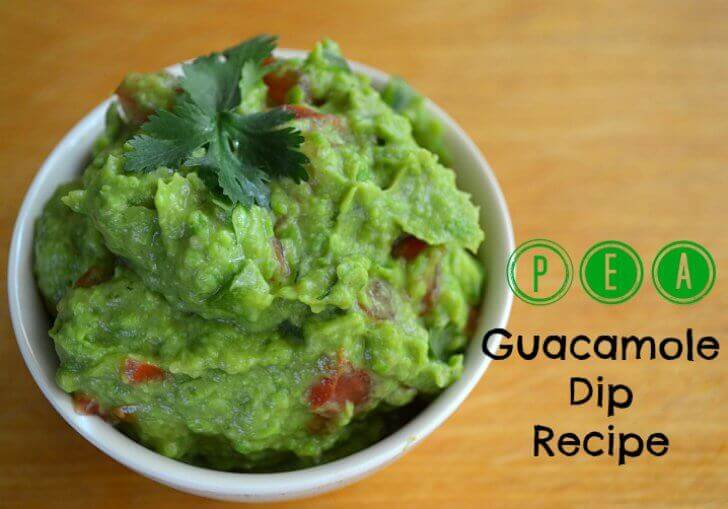Eating Seasonally This Spring: An Interview with Shannon of Nourishing Days
If you’ve ever thought about learning to eat more seasonally, now is the time.
Farmer’s markets all over the continent are beginning to open up, and overflowing with seasonal harvest like peas, lettuce, spinach and other green leafies, garlic, strawberries, rhubarb, green onions, fresh herbs and more.
One of our contributing writers here at KOTH also happens to be a huge advocate of eating locally, seasonally and sustainably. So much so that this past winter she put out her first ebook, Simple Food {for Winter}, with a focus on eating whole and nourishing foods, but sticking to foods that were actually available in winter (which includes foods that had been preserved in various manners).
Following up on that book’s success, Shannon has now crafted another ebook full of enticing recipes, and inspiration for those who want to eat seasonally with the freshness of the spring harvest. It’s called Simple Food {for Spring}.
An avid gardener myself and advocate of local and seasonal foods, I think that Shannon has such an amazing passion for this topic and she makes it look so darn easy. I asked if she would mind being interviewed and let some of her knowledge and passion rub off on the rest of us…
Me: Your cookbooks are based almost entirely off of seasonally-available foods… what does the meal creation process look like for you? Do you start with what’s growing, or what’s in the farmer’s market, and go from there?
Shannon: Yes, pretty much. I find myself inspired by what ever I am finding in the garden or at the farmers market. Trying to eat only what is in season or what one has stored up also helps because you have a certain set of parameters when you decide on a menu or a specific dish.
Plus, with two small children, a garden, a home to run, and a husband I want to spend time with I like to keep things super simple. The baked eggs with spinach dish from the spring cookbook fits all of these parameters – seasonal abundance (spinach & eggs), nutrient-dense, and it cooks in one pan in under 10 minutes.
Me: Your family is in the process of moving off-grid, with plans to homestead and live an even simpler and more sustainable life. What inspired that and how has that changed the way that you eat?
Shannon: That is such a hard question because so much has inspired that. I am currently writing a series on our journey to agrarianism that shares the why behind it. The first part of the series discusses our family’s convictions to live without debt, outside of consumerism, and in a way that is directly dependent on God’s provisions.
I am currently writing the 2nd part of the series that involves some more personal and political occurrences in my life; namely how sending my brother to war changed my path and perspective. Ultimately, though, the why has to do with God and how He calls us to live.
Living this way (which we are preparing to do in a few months) has forced me to question everything I thought I knew about the way we eat and the way we cook. We want to be able to grow and raise much of our own food and barter for that which we do not. So again, it really makes you get creative in the kitchen but also brings a sense of gratitude to the table that you can never have when you are dependent on the current food system.

Me: Having two young boys, with voracious appetites if they’re anything like my own children, do you find it a challenge to feed them seasonally? Do they struggle with wanting favorite dishes or not comprehending why cucumbers or strawberries aren’t an option in the winter?
Shannon: Oh yes. When we head into our local health food store there is a lot of “Look mama, tomatoes!” in January and “Can we get strawberries?” in December. But I think it’s actually easier for them to let go of these things at this age than it is for some adults. I remember when I first began to think about eating seasonally and found it hard to pass up tomatoes in winter. But then when we started getting into the rhythm of the seasons… well, tomatoes are just so good in August and strawberries are such a treat in June.
And it helps, I think, that our boys pick things out of our garden or join us at the u-pick farms for berries and eat plenty of them in season.
Me: How have you found your own tastes and food cravings shifting with this focus on intentional seasonality?
Shannon: I think it just comes naturally when you want something (freedom) as badly as we do. Most of the time it doesn’t feel like going without.
Late winter and early spring are the hardest times of the year, to be sure, and I won’t pretend like I didn’t buy a bunch of greens or a head of lettuce before it was available locally. I had hoped our little hoop house would provide longer than it did. After a long winter it is really easy to actually crave those bitter greens because the only green thing you’ve eaten all winter probably came in a can.
Eating seasonally is a process whose end goal can only be achieved after a period of working to have food available year round. The shift is a process.

Me: What are your best tips for making spring’s fresh greens more palatable to those who struggle with eating them? Any recipes that do a particularly good job of pleasing even the most-reluctant eater of greens?
Shannon: Use plenty of fats when you are cooking and pair the greens with something rich. If you look at age-old cuisines you will find that Italians, for instance, often pair bitter greens with rich sausages. The balance that is created is really yummy.
When I first started eating greens it was at my midwife’s order during my first pregnancy. I tried sauteing them, but still had to choke them down. Putting them into soups, stir fries, or even the greens burgers in the spring cookbook is a way to get a lot of them in without having your family staring them in the face. I’m all about serving up tons of greens, but if your family won’t eat that green pile you put on their plate then you’re wasting your time and resources, right?
Want to get your own copy of Simple Food {for Spring}?
 It’s available here, for only $10.
It’s available here, for only $10.
It includes 28 recipes, which are not only full of spring goodness, but also happen to be grain-free. The color photos are beautiful, and in true Shannon style, the recipes look delicious. The one-pan stuffed shells recipe caught my eye immediately, the Greens Burgers just might fly with the kiddos, and the salad dressings are a must-try.
Disclaimer: I am a proud affiliate of Shannon’s ebooks, and am happy to be able to share them with my readers. I make a small commission when you buy one through one of my links, which you are not obligated to do, but it helps to support this site. So thank you!






Very interested in this cookbook. Although seasonal vegetables are different every where. Here in FL we don’t have green until Nov-Feb.
@Katie, Of course, seasonal will be very different for those more in the South. Almost opposite, right?
@Stephanie @ Keeper of the Home, I agree. I’d love it if Shannon could write regional seasonal ebooks, because our ruhbarb, asparagus, and greens are all but gone in the heat of the summer ;-). Don’t know how practical that is, but I’d definitely be interested in it!
@Steph (The Cheapskate Cook), Or, once she has them all written, it might work to just swap the seasons for what applies to where you live. So you might use Spring in Winter, etc. but hopefully there would be a book that works for each of your seasons. 🙂
I love this! I’ll have to check out her cookbook for more recipes! My family has also been striving to eat more seasonally (for a variety of health as well as financial reasons). And, well it’s just more “green”.
This is so relevant to me as my last 2 posts have been on 5 “Green” Reasons To Shop At Your Local Farmer’s Market and Tips For Organic Gardening At Home.
Ooh, I would love more ideas on how to eat those green leafy veggies. I’m supposed to be including them in my diet too (per midwife’s instructions… 🙂 ), but they’re making me gag. Usually I can tolerate them just fine, but there’s not a chance right now! Thanks for the good info in this post!
@Diana, When you can’t eat them straight, I find that blended in smoothies is a good alternative. Or chopped really small and cooked into an omelet. Or maybe a yummy, cheesy spinach dip? You just have to get creative. 🙂
@Diana, I agree with Stephanie, though in early pregnancy I find it easier to just try to get some calories in and then hit the greens hard once you feel up to eating in general :).
stephanie i love your blog. just found it googling “natural stain remover” and realized you have lots of great info on things i am interested in: cast iron cooking, caps diet, using the baking soda and vinegar hair regimen. thanks so much for all of the great info!!!
@miriam, Welcome, Miriam! Glad you’re finding useful information and please join in with us in all the great discussions! 🙂